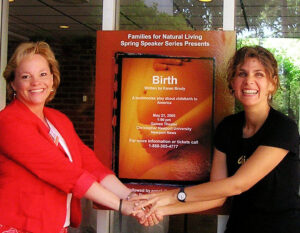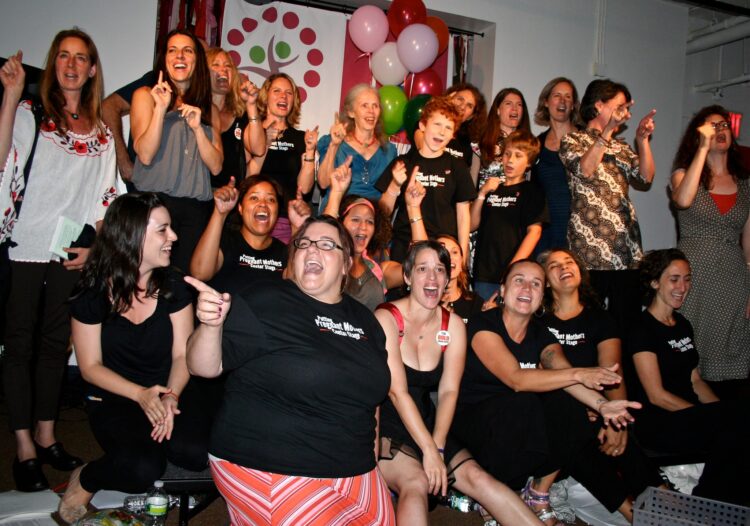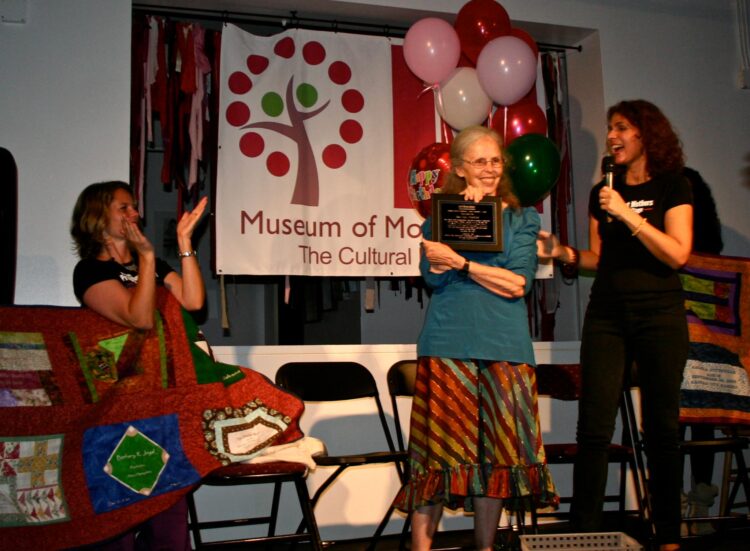FCL Celebrates the New Museum of Motherhood in NYC with BOLD
FCL Celebrates the New Museum of Motherhood in NYC with BOLD
An Interview With Karen Brody, BOLD Activist And Birth Playwright
(See photos of the event here. Scroll down to watch an impromptu discussion between Karen Brody and Ina May Gaskin about Birth the play and the movement, or go here. Read articles by Karen and her blog on Kindred.)
Families for Conscious Living, FCL, joined a slate of VIPs from the natural birth movement to celebrate the opening of the new Museum of Motherhood, MOM, in New York City on Labor Day, September 5, 2011. A sold-out audience watched a live, simultaneously webcast performance of the internationally acclaimed play Birth by Karen Brody. The webcast of the play was viewed in twelve countries and will soon be available on a DVD.
The post-show ceremony honored BOLD 5 activists and presented the godmother of midwifery, Ina May Gaskin, with a Lifetime Achievement Award. Ina May accepted the award with members of the cast displaying her Safe Motherhood Quilt on stage. The BOLD5 VIP activists were: Theresa Shaver, Executive Director of the White Ribbon Alliance for Safe Motherhood; Ricki Lake and Abby Epstein, producers of the documentary The Business of Being Born; Christy Turlington of No Woman, No Cry and Every Mother Counts; Debra Pascali-Bonaro of the documentary Orgasmic Birth; and Kirsti Kreutzer and Anna Van Wagoner of Where’s My Midwife?
Positioned alongside New York City’s Museum Mile, MOM is the first museum of its kind with a commitment to be a “social change museum focused on amplifying the voices and experiences of mothers, while connecting the cultural family.”
“I founded MOM out of love and because it needed to be done,” says Joy Rose, MOM’s executive director. “The vision includes a fully empowered, financially abundant facility that serves the local and global community to study, educate and disseminate everything mother.” Rose is president and founder of Mamapalooza Inc, and was appointed the Susan B. Anthony Award from the National Organization of Women, NOW, in 2009.
The MOM performance of Birth was especially passionate and significant as most of the actors were birth professionals and educators. Birth is a testimonies play based on over one hundred interviews with mothers. The play tells the birth stories of seven women, offering a range of perspectives on how educated, middle-class, low-risk women give birth.
In her endorsement for Birth, Christiane Northrup, MD, has said, “The Vagina Monologues has helped free vaginas the world over – as well as their owners. Now it’s time to do the same for the birth canal – and pregnant women everywhere. And that is the power and glory contained in this magnificent, funny, and wonderfully wise play.”
FCL was especially proud to be a gold sponsor of the BOLD event as FCL produced the first theatrical production of Birth in 2005 in honor of the legalization of midwifery in Virginia. The internationally acclaimed play has since been performed in a wide variety of settings, from a riverboat in the Siene, Paris, to a women’s correctional institute near Seattle, Washington. (In celebration of FCL’s 15th anniversary, FCL will return to MOM to co-sponsor a Mindful Mothering conference on November 7, 2011.)
In an interview with Lisa Reagan, Kindred Community’s editor and FCL’s co-founder, Karen Brody shares her adventure over the past six years as Birth became an international phenomenon, the BOLD movement raised nearly a million dollars for local birth initiatives, and her plans to help mothers move from FEAR to FREEDOM.
Lisa: What do you remember about FCL’s first theatrical production of Birth in 2005?
Karen: When you did it, I was very unsure how it was going to be used. The reaction to the script reading at the Coalition for Improving Maternity Services [CIMS] conference in March 2005 was pandemonium. It was, “OMG! There’s a play about birth!” I started to get 50 emails a week of people asking me to do the play. I had no parameters set up to do the play. I was sort of letting people do it and coming up with a price for what they would pay me, but I loved the model of Vagina Monologues and its ability to create social awareness and change. I wanted to raise money to make maternity care better for moms.
In 2006, I decided for one weekend to let anyone who wanted to use the play buy the kit and the script. Most groups didn’t have a lot of money to do the play, so I created a way for them to do the play that was a win-win for me and them. Twenty-one locations did the play in 2006 within four days around Labor Day and that was the real beginning of BOLD – Birth on Labor Day!
Since then, a lot of people have used the play to affect legislation, affect birth options in their community, and to raise money for birth centers. Nearly a million dollars has been raised in the past five years! In Ontario they were protesting the closing of their birth center and, you know, that birth center was opened again. And that is how I want the play to be used.
During the first FCL performance I was sitting in the back so I could see the audience’s reaction. I am also a shy person in general. But those were the early days. Now I am on stage rocking out with everyone!

Lisa: So it all began with Birth and now it’s an international movement, BOLD, that has branched into Red Tent gatherings where women tell their stories, and now the new FEAR to FREEDOM Birth Facilitators Training Program?
Karen: The acronym was just too good to pass up, to say we were going to do birth on Labor Day, you know, “Do you want to be BOLD this year?” But then we realized to do theater on labor day weekend is tough, especially for families who are traveling, and schools are about to start too, or they have started. So, we decided to make it the whole month of September. And then after that we just allowed it to be done year round.
Of the money that gets raised, 75% goes to groups and organizations that help low-income women have better births. I am happy about that because the play is not about low-income women. These are educated women who are talking in the play.
Lisa: Where are some of the more interesting places Birth has been performed?

Karen: The really interesting places have been on this riverboat down the Seine in Paris, and then in 2007 the play was performed outside Seattle in a women’s correctional facility. And they also did what we call a BOLD Red Tent, with Penny Simkin, to have the women tell their birth stories. It is really important to have women tell their birth stories where they will be safe and honored. So they did this in a BOLD Red Tent with the women in the prison there. There has been a BOLD Red Tent in Uganda, with women telling their stories there.
There have been locations that have done performances directly in hospitals and had talk backs with medical staff. It is better sometimes to take Birth to the medical staff as it is safer for them to talk through these issues instead of them coming to public performances. Lots of people have tried to bring in the medical community, but Asheville, North Carolina, was very successful in doing this. In New York some of the OBs have asked to bring the play into their residences to teach medical students and the whole staff at the hospitals.
The play was taught as part of the University of Florida at Gainesville’s Human Sexuality class. I got to blog and interact with the students after this performance. Rae Davies, the former executive director of the Coalition for Improving Maternity Services, CIMS, went to talk with them afterward. The students had so many things to talk about they had to continue their questions through the next session.
Lisa: Birth seems like an ideal play for college campuses. What has been the reaction to it there?
Karen: It brings up so many emotions for students, and all people – that women could be treated this way and that it borders on human rights abuse. But they also have a hard time believing that birth could be beautiful. So it is either a joke or a 911 incident. The play shatters so many perceptions, sometimes they get mad, but some of the audience members say thank you, “I know my body rocks”. Some people say, “You are lying. I can’t believe this. I was frightened by the stories.” This is why all of the plays are required to have post-show discussions with the audience, because you cannot give these people these issues and then not give them an opportunity to talk about.
It is a hard topic but someone has to write it down. That is what I felt about this play. What if nobody knows these things? What if pregnant women don’t know? If you don’t know you can’t change anything.
Lisa: What inspired you to become a first time playwright and write Birth?
Karen: I had both of my boys at home. People ask me if I had a traumatic birth experiences, but I did not. But I heard so many women on the playground telling sad stories of their hospital birth experiences and I thought, how can this be true?
And then I attended a blessing way for a pregnant mother and one of the older family members told her birth story for the first time. She had never told anyone what she went through giving birth in the 50s. I was shocked about the torture of pregnant women in the 50s and how none of those stories had been recorded. Many of those women were going to die with their birth stories untold. It made me think about the skyrocketing C-section rate today and what if nobody knows? What if there are women living with their PTSD [post traumatic stress disorder] for years and nobody knows? On the other hand, what if nobody knows about the joy they experienced? I didn’t want this birth crisis that we were in then, and we’re still in now, to not be recorded. I thought about writing a book, but I wrote a play.
Lisa: What are you doing next?
Karen: The FEAR to FREEDOM Birth Manual is coming out in 2012, with all of the methods that I have been teaching birth educators and doulas. I want mothers to understand that their body’s rock!
The workshops I’ve done have seen so many pregnant mothers transformed that decided to now train birth workers to teach pregnant women these tools because I want to see more women empowered this way. I want birth to change and I think we need to get the right books in people’s hands. There are good books out there, but they are not getting into the hands of moms.
Over the years, people have had to record all of the performances and post-show discussion, so I have videos of all of this and we’re beginning to create an exhibit that we hope to put in places like the Museum of Motherhood.
Lisa: How does FEAR to FREEDOM work?
Karen: It is a Body, Voice, Action approach to connect with your body, to discover you authentic voice and then to take action to have the birth you want. You can find out what are the underlying issues stopping you from following your vision. It is not a blueprint, but if you get mothers into their bodies and then strategize how they are going to have an empowered birth and then take action, this is really empowering.
We use Clarissa Pinkola Estes’ work on following your intuition and discuss stories that guide us to do this. FEAR to FREEDOM Birth Facilitators are trained to use three stories from my play Birth to help mothers realize that birth can be a Fear to Freedom journey. I thought about writing another play, but I am dedicated to shifting this paradigm in childbirth so I want to try that with this BOLD and Fear to Freedom program. I have been in so many talk back programs where mothers say they lost their voice and their power, or they didn’t have it before they got to the hospitals.
We can’t really expect pregnant mothers to make empowering birth choices until we help to ground them in their bodies and give them tools to use their voices and take action. You don’t know until you know that you don’t know. There are four levels here, physical, mental, emotional and spiritual and these are the four areas that need to be awakened in pregnant mothers so they can demand better birth choices.
Lisa: I hear there is a new twist in the upcoming NYC premier? (this interview took place right before the NYC Labor Day premier)
Karen: The new story in the play is a VBAC. “In the orginal Birth script, Sandy had a traumatic C-section for her first birth and the play ends with her having a conversation with her mother about having a VBAC. The new Birth script premiering in September that’s going to broadcast around the world via webcast now picks up Sandy’s story from that moment an follows her through her second birth story, an empowering VBAC that almost didn’t happen. It is a great story, because Sandy is still having a hard time in the second birth going against family pressure. It is exciting that the play has a VBAC story. I am already getting supportive emails about this from VBAC moms who haven¹t even seen the play.
For more information on Birth, BOLD, FEAR to FREEDOM or Karen, visit here.
For fascinating insights on the play Birth and the movement between Karen and the godmother of midwifery, Ina May Gaskin, watch the video below. The impromptu discussion was caught by Lisa Reagan at Ina May’s radio interview with Diane Rehm in Washington, DC, in July 2011.















